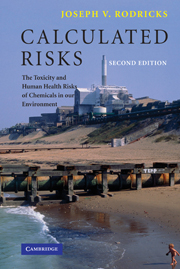Book contents
- Frontmatter
- Contents
- Preface to the first edition
- Preface to the second edition
- List of abbreviations
- Prologue
- 1 Chemicals and chemical exposures
- 2 From exposure to dose
- 3 From dose to toxic response
- 4 Toxic agents and their targets
- 5 Carcinogens
- 6 Identifying carcinogens
- 7 Risk assessment I: some concepts and principles
- 8 Risk assessment II: applications
- 9 Risk assessment III: new approaches, new problems
- 10 Risk assessment IV: the courtroom
- 11 The management of risk
- 12 A look ahead
- Sources and recommended reading
- Index
2 - From exposure to dose
Published online by Cambridge University Press: 25 August 2009
- Frontmatter
- Contents
- Preface to the first edition
- Preface to the second edition
- List of abbreviations
- Prologue
- 1 Chemicals and chemical exposures
- 2 From exposure to dose
- 3 From dose to toxic response
- 4 Toxic agents and their targets
- 5 Carcinogens
- 6 Identifying carcinogens
- 7 Risk assessment I: some concepts and principles
- 8 Risk assessment II: applications
- 9 Risk assessment III: new approaches, new problems
- 10 Risk assessment IV: the courtroom
- 11 The management of risk
- 12 A look ahead
- Sources and recommended reading
- Index
Summary
To determine whether and to what extent humans may be harmed (suffer toxicity) from a chemical exposure, it is necessary to know the dose created by the exposure. The concept of dose is so important that it needs to be treated in detail.
Exposure, as we have seen, refers to an individual's contact with an environmental medium containing a chemical or, in some cases, with the chemical itself. The amount of chemical that enters the body as a result of the exposure is called the dose.
The magnitude of the dose is a function of the amount of chemical in the medium of contact, the rate of contact with the medium, the route of exposure, and other factors as well. Experts in exposure analysis use various means to estimate the dose incurred by individuals exposed to chemicals. Exposure analysis is one of the critical steps in toxicological risk assessment.
Common expressions of dose
Everyone is generally familiar with the term dose, or dosage, as it is used to describe the use of medicines. A single tablet of regular strength aspirin typically contains 325 milligrams (mg) of the drug. An adult takes four tablets in one day, by mouth. The total weight of aspirin ingested on that day is 1300 mg, or 1.3 grams (1 mg = 0.001 g). But weight is not dose.
- Type
- Chapter
- Information
- Calculated RisksThe Toxicity and Human Health Risks of Chemicals in our Environment, pp. 28 - 53Publisher: Cambridge University PressPrint publication year: 2006



